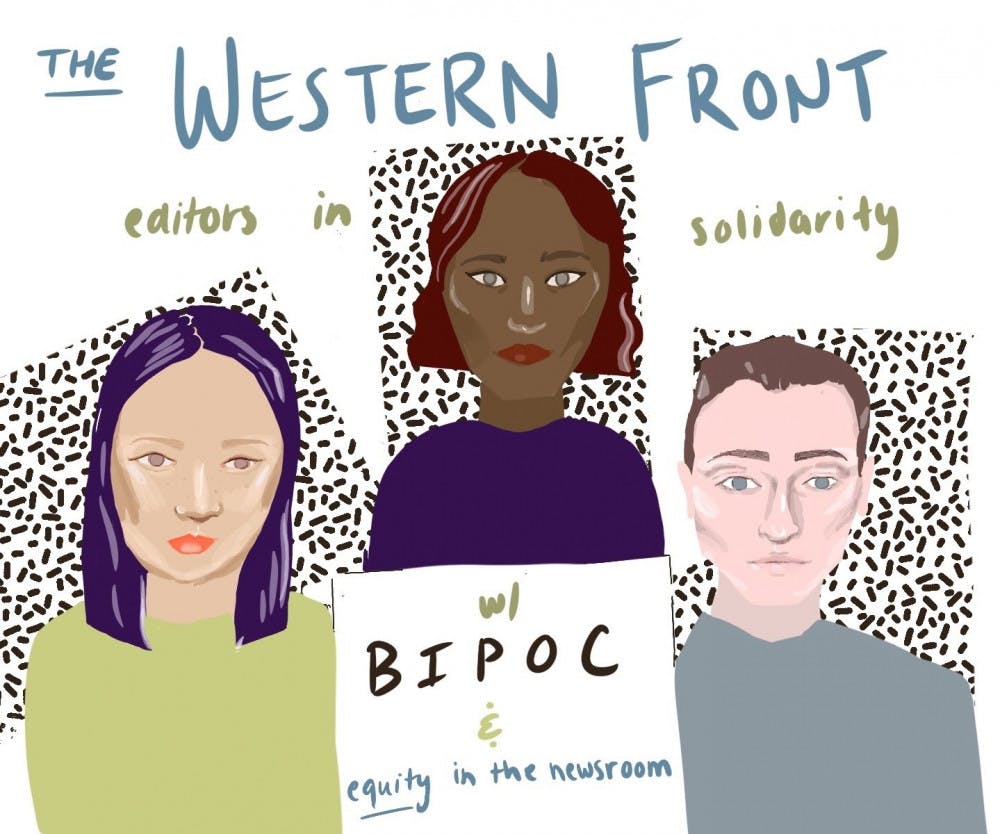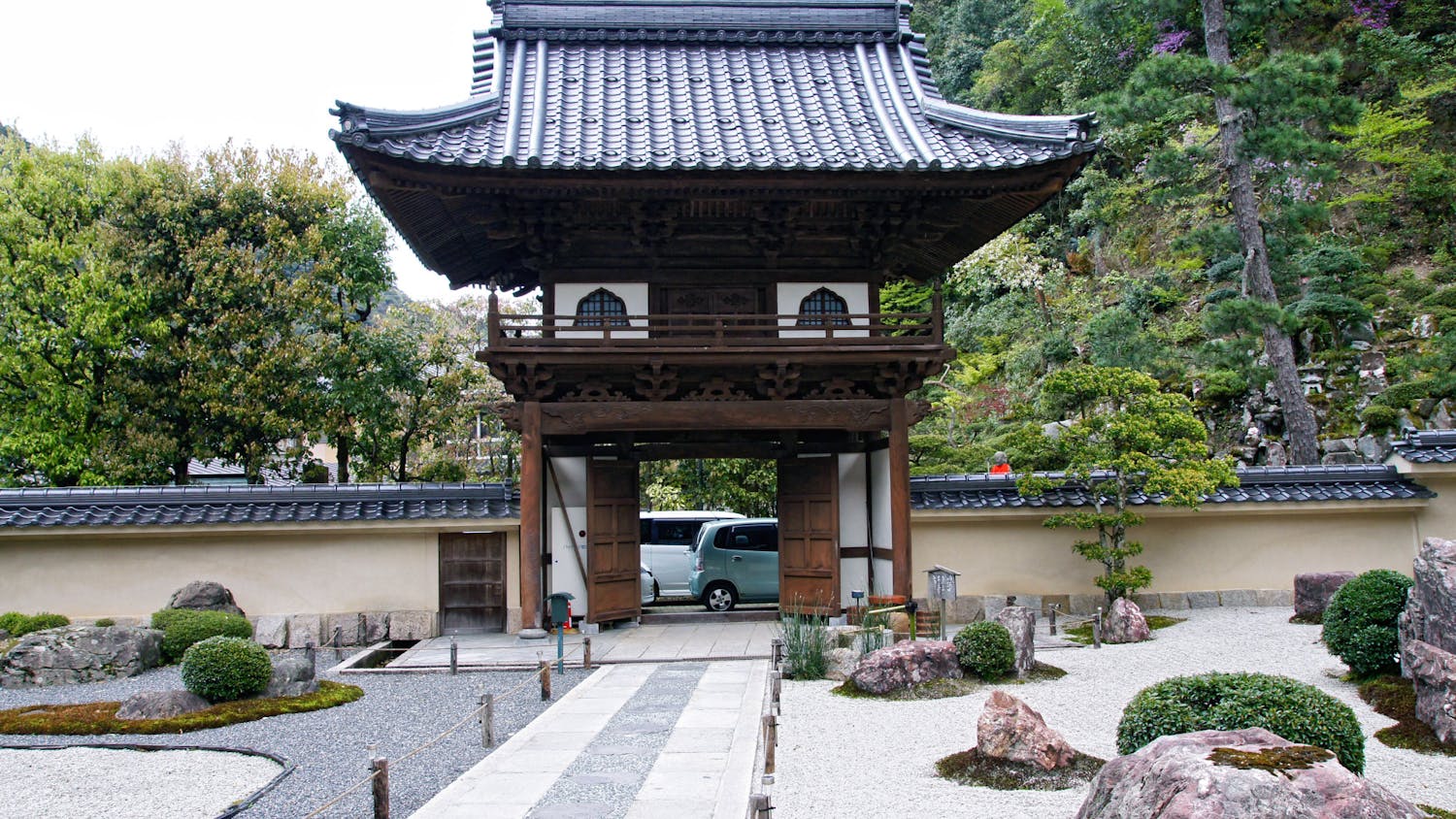Changes made to address current violence toward BIPOC, bias in our reporting

From microaggressions to physical violence, systemic racism is an ongoing problem in the U.S. Xenophobia and hateful attitudes toward Asian Americans emerged with the start of the COVID-19 pandemic. The Black Lives Matter movement has sparked an increase in reports of police brutality against Black people and their allies.
Bellingham and Western are not exceptions to this problem. One instance of recent racism at Western includes stickers and posters promoting the Patriot Front, a white supremacist group, being posted on light poles across Western’s campus, according to the June 5 announcement from Western Today. The Front stands with Black, Indigenous and all other communities of color during these local and national acts of racism.
On June 3, the spring quarter editors offered a statement of solidarity with Black Lives Matter. This summer, the editors and staff are furthering that commitment and offering clear standards for how the Front will work on covering these problems. Our goal is to be accountable and transparent about changes we have implemented in the newsroom, and to leave future editors with a roadmap for just and equitable coverage of our community.
At its core, journalism operates as an institution to inform its audiences. But what is the outcome when decades of structural and institutional racism have affected how journalists choose what stories are told?
Wesley Lowery of The Washington Post said it concisely: “The failure to employ, retain, and listen to Black people is linked with the failure to accurately cover Black communities.”
In 2000, the American Society of News Editors reported that only 9% of newsroom supervisors identified as minorities, while consisting of 28.4% of the U.S. population. In 2017, minorities represented 16.6% of the U.S. newsroom workforce — that same year, the Black community alone represented 12.7% of the nation's population. Although the number of minority journalists employed at newsrooms has seen an increase, the dominant voices coming from the majority of publications are not reflective of the communities they report for.
Bellingham specifically is a disproportionately white city where over 80% of residents identify as white. Because of this, the voices of minorities are not represented in many spaces, including newsrooms such as the Front. According to the 2000 and 2019 American Community Survey, there was a less than 1% increase in the Black population during the past two decades. Other communities of color, including the native Salish Sea Tribes and Latinx populations, are also underrepresented due to the history of structural racism in our city. Increasing the minority representation in our newsroom at the Front might look different than other newsrooms. There may not be as much of an increase in minority journalists as newsrooms in other cities, which have different numbers of minority populations.
In an effort to appear more credible to audiences, the journalistic norm for a long time was to report “both sides.” False equivalencies — for example, interviewing a climate change denier’s opinions with the same seriousness that we report the vast majority of climate scientists’ peer-reviewed research — can obscure the reality of a story merely to create a facade of neutrality. Journalists must shift their goal from reporting all sides of a story to reporting fairly and factually.
To do this at the Front, we have entered conversations with current and former journalists who have done anti-racism work. Gabrielle Nomura Gainor, communications and public engagement manager for the Seattle Opera, a Western alumna and a former journalist, worked on amplifying the civic engagement and anti-racism work in the Opera, according to her LinkedIn.
Gainor emphasized the importance of holding ourselves, the journalism department and Western as a whole accountable for how we work with and for communities of color. She gave us a list of questions to consider as we are writing each story, which will be passed to future editors with the intent that the questions will be shared with future reporters.
These were the questions she sent us via email, and brief answers from our editing staff:
- How is your publication going beyond colorblindness and normalizing issues of race?
We recognize that the Black Lives Matter movement is not a political issue, but an issue of human rights and systemic injustice. Furthermore, we believe that problems affecting BIPOC are important for everyone, and therefore won’t be relegated to a specific “social justice” beat, although we welcome people to contribute guest columns to illuminate, challenge, or add complexity to our reporting.
2. Are your stories reinforcing the status quo or providing new information?
For every story we write, editors will consider if we are reinforcing the status quo or if we are providing new information and working to break down barriers as a crucial step in our editing process.
3. What is The Western Front’s relationship like with individuals and student groups of color? How can those relationships be strengthened?
We are aware that our current relationship with individuals and student groups of color isn’t as strong as it needs to be in order to do our job to serve the community. We are trying out a process called public-powered journalism, which begins with community feedback, and the community “assigning” stories to the newsroom by suggesting questions that need the power of journalism behind them. We are making an effort to reach out to the community on social media and ask what you want to know.
4. In what ways has The Western Front failed in its reporting of race, or lack thereof?
As part of our role in telling our community's story, we send photographers to protests, a decision that, in some cases, can either dissuade public protests or result in retaliation against protestors.
Emily Feek, the incoming editor-in-chief of the Front, did a content audit of the Front’s stories involving the Ethnic Student Center (ESC) clubs, identifying the Front’s habits of sourcing (relying on the same people to represent diverse communities, over and over again) and coverage (focusing on events and protests rather than developing regular and varied coverage of minority communities). In the past, we made a poor habit of mentioning the ESC clubs in articles, often articles pertaining to AS elections, and failed to reach out and include their voices. Our lack of story diversity has led us to report on ESC clubs either in reference to large events or conflict, focusing on controversy faced by communities of color rather than their club identity and contributions to campus. Our focus on high-visibility events rather than specific clubs suggests surface level interest rather than sincere interest. While some clubs did get some coverage due to these events, others got none and have not been reported on by the Front. In 2018, the Front published a series of four articles over the span of two weeks about the Oceanic Student Association, pertaining to a Western Athletics Hawaiian-themed event. The club made a public statement saying that the event was culturally insensitive and lacked awareness. The first article was about the specific athletic event while the other three were about representation and cultural appropriation on campus. The statement made by the Oceanic Student Association was the only source included on behalf of the club. These four articles were the only articles about the club over the span of three years. The published story “1968 to now: How BSU spoke out on need for Black Student support” which focuses on the Black Student Union’s history on campus, is another example of systemic faults within the Front. The sources primarily consist of public statements and past Front articles and failed to discuss the current work of the Black Student Union or have statements from current members. These are a few examples of how the Front’s previous practices concerning BIPOC are lacking, due to the Front as a whole. This is not an attempt to place blame on the reporter(s), but to identify the practices that we aim to improve. It shows that the Front rarely publishes stories on ESC clubs that are not related to controversy, and that the newsroom has a shallow sourcing list. We are working toward repairing our broken relationship with BIPOC by improving coverage and sourcing.
5. How has The Western Front incorporated anti-racism into its newsroom culture?
We are regularly having conversations as a newsroom about the racism in journalism and specific steps we can take to make the Front an anti-racist organization. We have instituted new policies, outlined below, and are asking student groups of color what we can specifically do to provide accurate and consistent coverage of their daily experiences. In editors’ meetings and with reporters, we frequently discuss the history of racism in journalism and outline the current racist structures built into journalism, such as how implicit bias affects everything from source selection to how dark skin tones appear in images, and how to replace these structures with better ones.
6. How are you reporting on systemic inequity at Western?
We work independently from Western and have the responsibility to use our platform to hold Western accountable. Especially during COVID-19, we rely heavily on tip-offs from the community and we hope that as we strengthen our relationship with our neighbors, classmates and colleagues, we can better understand what we need to cover.
7. In what ways are student journalists decolonizing their journalism education, journalism mentors, educational materials, and news sources?
We are actively educating ourselves about the racism in journalism. One example of this is our conversation with Gainor. We are working with Feek to ensure the work we have started this quarter will continue.
8. In what ways are student journalists actively addressing their own biases?
Reporters and editors take implicit bias tests and regularly discuss structural methods to disrupt our biases, known or unknown, but we are aware that these tests have problems and that being aware of implicit bias without actively addressing it is not enough. We aim to narrow the space for implicit bias to affect a reporter or editor’s work through our new policies.
This is a powerful, but not comprehensive list, and there are many more things to consider while working on the decolonization of journalism.
We are editing our editorial policies, a living document that student editors revise as needed, to reflect the changes we hope to accomplish.
One of our new policies anonymizes our hiring process. Prospective editors and paid student employees submit their applications to the current editor-in-chief or faculty adviser, who removes any identifying information before passing the applications to the incoming editor-in-chief. The editor-in-chief will make all decisions on who to interview before the identifying information is revealed. We have implemented this change — which has most famously been used for “blind” musical auditions, resulting in more diverse orchestras — to reduce implicit bias during our hiring process.
We have also created a policy that requires all of our stories to include the voice of someone directly affected by the issue the story covers — for example, in reporting about homelessness, we expect reporters to speak with people who have experienced homelessness. The policy specifies that if a story covers a group of people, it must include the voice of at least one person who is a member of that group.
Another one of our policies will require our reporters to ask how sources would like to be identified and referred to if their identity is important to the story. They will also ask sources if they would like a phonetic spelling of their name included, so readers know how to pronounce it. We hope that these changes will communicate respect for our sources and help rectify our history of excluding marginalized communities from our coverage.
Finally, we are committed to hearing directly from the community. We will be adding a page on our website where members of the public can easily submit letters to the editor, guest columns or freelance reporting. These will be edited minimally before publication to meet WF Style guidelines and for length, spelling and grammar. Anyone is welcome to email the editor-in-chief, whose email should always be easily found on our website under our “About” section.
We want to know what you need us to do to serve you, and we recognize that we need to do more to meet the challenge of ethical journalism that accurately represents our entire community.
If you would like to submit a letter to the editor, a guest column or have any other questions or concerns, please send them to eic.westernfront@gmail.com.
Sincerely,
Jordan Kiel (Editor-in-chief)
Afsara Sadiya (Managing Editor)
Izzie Lund (City News Editor)
Hailee Wickersham (Campus News Editor)
Kiki Huntington (Features Editor)
Rebecca Lehman (Online and Social Media Editor)
Thomas Hughes (Photo Editor)
PJ Heusted (Copy Editor)
Riley Kankelberg (Copy Editor)





